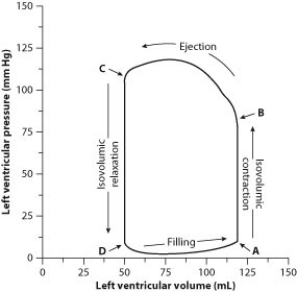Multiple Choice
To evaluate cardiac function, scientists and physicians measure both the pressure and the volume inside the heart. When both pressure and volume data are plotted on the same graph, the resulting graph is called a pressure-volume loop. To create a pressure-volume loop, a catheter (a thin tube) is inserted into the vessels of the heart, and measurements of both left ventricular pressure and left ventricular volume are taken. The data are plotted on a graph, and cardiac function can then be evaluated from the distribution of the data and the shape of the loop.
The following figure shows a typical left ventricle pressure-volume loop for a healthy young adult. The cardiac cycle proceeds counterclockwise. Each complete turn around the loop (for example, starting at point A and ending back at point A) represents one complete cardiac cycle.

-At what point on the diagram does the aortic valve (the semilunar valve that separates the left ventricle and the aorta) open?
A) point A
B) point B
C) point C
D) point D
Correct Answer:

Verified
Correct Answer:
Verified
Q66: Ron and Tiffany are studying circulatory
Q67: At any given time, what percentage of
Q68: During which phase of the heartbeat do
Q69: Electrocardiographs (ECGs or EKGs) provide data about
Q70: The main function of the AV node
Q72: Which of the following is the cause
Q73: During exercise, your cardiac output can increase
Q74: Hematocrit is the percentage of red blood
Q75: From the left ventricle, oxygen-rich blood flows
Q76: You conduct a study with mice to